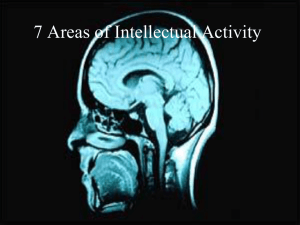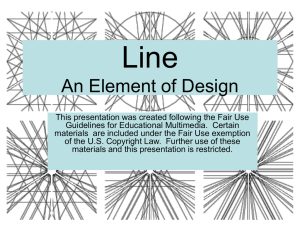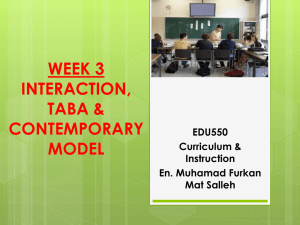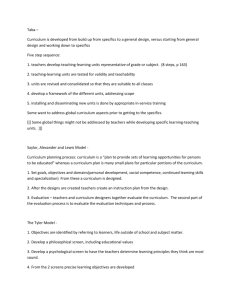File - Crazy for First Grade
advertisement
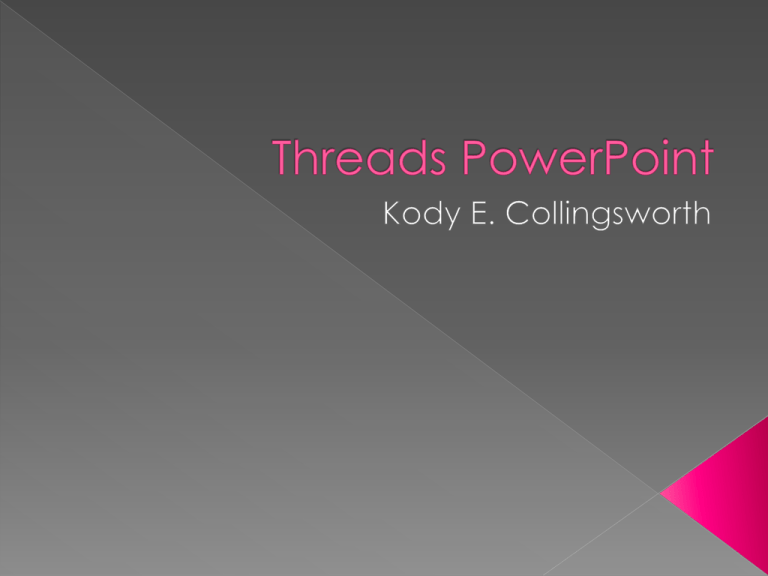
Dewey was deemed one of the most influential American philosophers and was world renowned for his way of thinking about education. He worked in philosophy, psychology, and, pedalogy. In his way Democracy and Education, he stated that “philosophy may even be defined as the ‘general theory of education’” (Hunt, Carper, Lasley, II, and Raisch). Dewey believed that overemphasis upon content and differentiating the unique differences of students was a better approach verses the individual needs of a student. www.prometheaeducation.com/wpcontent/uploads/2012/04/John-Dewey.jpg Dewey believed that one’s experiences arise from the intersecting of two principles: continuity and interaction. “One’s present experience is a product of one’s past experiences and the present situation at hand. Thus to teach effectively, one must be aware of what the student has learned before and see learning as constitutive and present in current learning” (Hunt, Carper, Lasley, II, and Raisch). quote.pixel.com/images/quotes/life/john-deweyquotes-8786-4.png One of the most influential and prominent curriculum theorists and educationists Interests in regards to education pertain to “cultivation and the promotion of new concepts of literacy within multiple forms of representation” (http://infed.org). Advocate for imagination with the curriculum http://news.stanford.edu/news/2014/janua ry/images/13403-Eisner_news.jpg In the 1960s, Eisner objected to the idea and purpose of curriculum planning in advance for intended learning outcomes. He challenged this behavior objective movement and came up with his alternative called expressive objectives or later on called expressive outcomes. This term, expressive outcome, is when a student emerges with purpose from an expressive activity. Believed activities should vary. http://youmeandcharlie.com/wpcontent/uploads/2013/09/ymc1.jpg http://www.moravian.edu/assets/base/imag es/aboutimages/buildings/comenius.jpg Johannes Amos Comenius “Grand-father of modern education” Comenius strategy for education was based on the strategy called “Pansophia.” This strategy was a philosophy built upon universal education (a universal language and education that included women) Believed that schools he came across were “the slaughterhouse of the mind.” Comenius felt that education was a following of nature not something forced upon others. He planned state schools that had a defined learning task for each hour of the assigned days, and that there would be a break called recess. Comenius plans for schools were radical at the time, but in todays schools, his idea is accepted and used. He was the first to use pictures in textbooks. Believed that education began in the earliest days of childhood and continued throughout one’s life He was an advocate for education for women (a concept that was un-thought of for this day and time). Published 154 books http://statusmind.com/images/2014/04/Education-Quotes-40379statusmind.com.jpg. 1884, Dow set sail for Paris where he became a student of Gustave Boulander and Jules Lefebre while in Paris. He saw many new styles and techniques. These new ways revolutionized his way of thinking artistically. He became inspired. 1889, he returned to Boston, his birthplace. He discovered new designed elements from observing a Japanese ukiyo-e print maker Katsushika Hokusai at the public library. Because of this new discovery, this led him to meet Ernest Reynolds. http://pocketknowledge.tc.columbia.edu/files_web _accessible/34323/3066_medlarge.jpg Together, they studied the various Japanese prints classifying them into: line, form, color, and notan. Dow further elaborated these new theories in Notan, his own book of his thoughts. Theories gave meaning and expressions to his work and left a mark on the art world through his books on American printmaking, painting, photography, and the decorative arts. http://www.aaa.si.edu/assets/images/dowarth/refer ence/AAA_dowarth_27563.jpg http://www.theartwolf.com/landscapes/georgia-okeefespring.htm American painter who was among America’s first generations of modernists. Best known for her flower canvases Studied at the Art Institute of Chicago in the early 1900s. Studied with artists like William Merritt Chase Alfred Stieglitz became her advocate for photography. Publically showed her work in public in 1916 for the first time with the help of Stieglitz Married Stieglitz in 1924 Popular early works were: Black Iris and Oriental Poppies Sky Above Clouds III/Above the Clouds III, 1963 Horse’s Skull with White Rose, 1931 http://www.okeeffemuseum.org/her-art.html Green Lines and Pink, 1919 http://www.stealthgenie.com/blog/digital-divide-istechnology-a-property-of-the-rich-only/ The digital divide is the people who have access and do not have access to a computer (internet access). It is the world’s access to the technology and the gap that is left for individuals (importantly students) who do not have access. It is underprivileged verses the wealthy who fill the spaces of the digital divide. As we move more into the 21st, we are becoming more reliant on technology. As years pass on, the gap grows larger instead of smaller Education has became dependent on technology and with children’s access limited, it is becoming harder to have students use technology outside the classroom. http://blogs.edweek.org/teachers/coach _gs_teaching_tips/2012/09/the_new_digita l_divide_1.html http://latinoschoolleaders.wordpress.com/2013/03/18/th e-new-digital-divide-academic-digital-divide/ http://dailytrojan.com/2011/10/02/reforms-tono-child-left-behind-are-positive/ An educational reform that became a law in 2002. This law came from the Elementary and Secondary Education Act of 1965. NCLB was the involvement of the federal government into education. It was established in the relation and reaction to academic performance, achievement, and stability. Required data to show improvement of students. The purpose of this was to mandate federal funds for reading and math programs deemed effective, ensure students achieve various learning outcomes, have well prepared teachers in a safe environment. It was also to close the achievement gaps of the students and raise the achievement scores. Most attention towards the requirements for testing, accountability, and school improvements Requires states to test annually in reading and math (for grades 3-8, and once in 10-12) Science testing is done once for the grades 3-5, 6-8, and 10-12. Goal: for the students to be proficient in grade-level reading and math by the year 2014 (Tennessee was an exempt state), Schools must make adequate yearly progress that is determined by each state. http://www.ed.gov/blog/tag/nclb/ http://superradnow.wordpress.com/tag/alexandercalder/ 20th century sculptor who was fascinated at a young age with creating objects that moved Born in Pennsylvania, Calder moved to Hoboken, NJ to attend the Stevens Institute of Technology, where he graduated with a degree in engineering Later in his life, he decided to become an artist. He studied the art of painting at the Arts Students League in New York City. In NYC, he was assigned to sketch circuses that later became a focus point of his work. In 1926, he moved to Paris, where he began creating portraits and figures from wire. He received great amounts of attention from New York, Paris, and Berlin. Inspired by other artists, he began to think abstractly and incorporated this thinking into his sculptures. By adding abstract and kinetic elements, Calder was able to create Mobiles, what he is best known for today. Calder constructed his artwork using wire, metal, and wood. He produced a wide range of artwork including: drawings, paintings, jewelry, and set designs. He was awarded the Presidential Medal of Freedom and Bicentennial Artist Award in 1976. Untitled, 1972 http://www.kcrw.com/etc/programs/a t/at120503alexander_calder_at_ http://www.pictury.org/hilda_t aba/images/taba_08.jpg Student of John Dewey Concern focused around formulating and implementing a specific teaching strategy in order to help students think more efficiently and effectively. Taba’s thoughts centered around the behavioral objective. She was a “theorizer.” Over her lifetime, Taba developed teaching strategies, each clearly defined for students, to encourage cognitive development. http://www.pictury.org/hilda_taba/images/taba_08.jpg http://rapidlearninginstitute.com/traininginsights/training-transfer-kirkpatrick-says-its-allabout-managers Developed the 4 level thinking model First established and published in 1959, and was updated in 1975 and again in 1994. These were published in “Evaluating Training Programs.” http://idassessment.wikispaces.com/Kirkpatricks+four+leve ls+of+evaluation Reaction-how trainees react to training Learning-what trainees have learned Behavior-based on training received, how has the trainees behavior changed Results-analyze your findings Known for being the creator of the kindergarten system and for putting emphasis on the idea of play. “The purpose of education is to encourage and guide man as a conscious, thinking, and perceiving being in such a way that he becomes pure and perfect representation of that divine inner law though his own personal choice; education must show him the ways and meanings of attaining that goal” (www.infed.org). http://www.britannica.com/EBchecked/topic/2205 93/Friedrich-Froebel Ambition: create environments suitable for working with varying materials. To understand, is to engage and explore. Developed wooden bricks and balls to aid in educational games. http://www.froebelgifts.com/gifts.htm http://www.huffingtonpost.com/2013/10/25/picassobirthday_n_4159306.html Avant-garde artist who was considered as one of the greatest of the 20th century. 1895- attended the School of Fine Arts in Spain and San Fernando Academy in the fall of 1897 and summer of 1898. Picasso not only known for his paintings. He made the discovery of cubism and invented the collage. Inspiration came from the culture surrounding Barcelona and Paris. The Weeping Woman, 1937 http://totallyhistory.com/theweeping-woman/ Le Reve (The Dream), 1932 http://www.huffingtonpost.com/noraephron/my-weekend-in-vegas_b_31800.html http://www.nndb.com/people/599/000115254/ Known as a sculptor and a collage artist He was a natural collector which allowed for him to be artistic and build/sculpt a collage and shadow box Became acquainted with Julien Levy, a surrealist art dealer, who showed Cornell’s work in his gallery In 1936, he created his first shadow box. 1938- “Untitled” (Soap Bubble Set) was created 1940- He became a freelance illustrator for various magazines like House & Garden and Vogue "Sirius," circa late 1950s http://www.miandn.com/artists/josephcornell/works/1/ Constructive artist who was born in Russia 1915-Gabo moved to Norway where he began making constructive sculptures (returned to Russia years later during the Revolution). 1920- wrote Realistic Manifesto, an explanation of his thoughts behind his art 1922- went to Berlin to show his art Gabo paved the way for constructive art. Sculpture by Naum Gabo in Rotterdam/The Netherlands http://en.wikipedia.org/wiki/File:Gabo_Rotterdam_2.jpg Started in the late 1800s and started to end around the early 1920s (while completely ending at the end of the ‘20s) Idea behind this movement was to beautify through art. This beautification (throughout the school, homes, and communities) was known as “Art in Daily Living” Promotes- to distinguish what is tasteful and truly art and develop a sense of art appreciation. Henry Turner Bailey wrote various books surrounding the picture-study movement. He wrote about the beauty that the art displayed and the representation behind it. http://www.drprabhatspeaks.com/TheAffectsOfStandar dizedTestingOnArtsEducation.html http://toto.lib.unca.edu/findingaids/periodicals/black_mount ain_college/default_black_mountain_college.htm Began in 1933 and was located in North Carolina A college based on John Dewey’s progressive education principles Josef Albers was the first art teacher Based on the idea “that the arts are central to the experience of learning” (www.blackmountaincollege.or g). Founding occurred with various historical events: rise of Hitler, closing of the Bauhas, and the oppression of artists in Europe Students included: Robert Rauschenberg, John Cage, and Merce Cunningham. http://justincampoy.tumblr.com/post/4875419650/josef-albersteaching-at-black-mountain-college http://stationtostation.com/participants/ro bert-rauschenberg-foundation/ 1947-discovered his love of drawing while in the marines (with increased focus around everyday things) After the marines, he studied art in Paris. Shortly after Paris, he moved to North Carolina and began and “artistic revolution.” After growing tiresome of North Carolina, he moved to New York to become a painter. Rauschenberg was an artist that thought outside of the box. He used nontraditional material like house paint. 1958- he created “Erased be Kooning” which marked a place in the world of art history. Throughout the years, he experimented with various ways and techniques of creating art. For example, in the ‘80s and ‘90s, he used collage to find new ways to take photographs and transfer them Monogram http://blanchardmodernart.blogspot.com/ Art teacher Wrote Drawing on the Right Side of the Brain in 1979 (which she is most known for) Late 1990s-founded the Center for the Educational Applications of Brain Hemisphere Research Edwards method to art was that the brain perceived and processed reality in 2 different ways. The ways were verbally and analytically and visually and perceptually. Edwards method focused on seeing what is drawn individually verses perceiving what it should look like before it is even drawn. http://www.learn-to-draw-right.com/bettyedwards.html https://mbasic.facebook.com/profile.php?v=timeline&timecuto ff=1394195795&page=6&sectionLoadingID=m_timeline_loading _div_1420099199_1388563200_8_6&timeend=1420099199&timest art=1388563200&tm=AQA39PiNiMHInQ_x&id=144118082280049& _rdr Established in 2001 by Massachusetts classrooms and integrated into the classrooms in 2007 Concept based around providing a more authentic art experience Purpose: providing students with choices of art to allow for more experiences http://www.artfulartsyamy.com/2011_07_01_archive.html DBAE: stands for discipline-based art education Began in the mid-1980s DBAE was promoted by the Getty Center for Education in the Arts DBAE redefined art to “beyond art making to include also art history, art criticism, and aesthetics” (Kindel). Goal: to incorporate more comprehensive arts into the curriculum. http://jeremyweber.wikispaces.com/DBAE Arts-based literature is bringing art into the literary world. Adding art into literature, brings the literature to life. It is used to enhance and support comprehension through dance, music, and visual art. It is used to increase skills in both art and literature. https://colorsofmyday.wordpress.com/catego ry/connecting-art-literature-in-the-art-room/ http://www.deepspacesparkle.com/2011/09/30/ art-and-literature-art-lessons-for-kids-2/ 1.) Philosophy of education-learning is built upon a strong belief about the value of diversity, creative inquiry, engaged learning and student independence. 2.) Arts literacy: content and skill- art concepts are taught to increase a student’s ability to communicate and problem solve. Art is a vehicle for communication across disciplines. 3.) Collaborative planning- co planning with classroom teachers and art specialists to facilitate a transfer of knowledge. 4.) Aesthetic learning environmentspositive attitudes towards learning, celebrating one’s diversity, respect, taking risks, and understanding help create a good physical and psychological conditions of a classroom http://www.washingtonparent.com/articles/1305/artsintegration.php http://www.montgomeryschoolsmd.org/schools/parkwoode s/ 5.) Literature as a core art formliterature is readily available material and can easily be integrated. 6.) Best practices- explicit teaching of how-what-why of art concepts, problem solving and the use of quality materials. 7.) Instructional design: structure and routines- keeping a schedule to set clear objectives for learning both academically and through the arts. 8.) Differentiation-allowing for different types of instruction for various learners strengths and weaknesses. 9.) Assessment for learning- to increase learning by using motivational tools. Motivate students to achieve success. 10.) Arts partnerships- co-planning to form partnerships for the arts. 20th century art movement Embraced: the fine arts, architecture, literature, theater, and film. “Term was used to describe an entirely new kind of creativity activity in which artistic skills were harnessed not to create works of art but to design practical objects of everyday use and total environments for the new society” (Merriman and Winter). Considered an avant-garde movement “The artist constructs a new symbol with his brush. This symbol is not a recognizable form of anything which is already finished, already made already existing in the world-it is a symbol of a new world, which is being built upon and which exists by the way of the people” (www.theartstory.com). Started in 1915 and ended in the late 1930s Vladimir Tatlin considered the father of constructivism http://www.tomchukfilms.com/articles/art_constructivism.php http://www.creativereview.co.uk/crblog/2008/august/constructivism-the-ism-that-just-keepsgivin Constructivism is how people learn and understand. It is how someone chooses to learn about something. It is said they learn through experience. Social Interaction Theory is on the basis of communication and how one engages with one another. Group Work-is working together for a common task in efforts to succeed or complete a task. When combined, these three all work on the basis of communication, experience, and collaboration to achieve a goal. http://www.thepowerofintroverts.com/2011/10/17/what-do-youthink-about-group-work/ 20th century modernist art school School’s approach was to understand the relationship art had on technology and society. Aimed to connect creating and manufacturing together again and to reunite the applied arts with the curriculum. Bauhaus means “house of building.” 1925- moved to Dessau, where architecture was incorporated into the curriculum (under the direction of Hannes Meyer). 1932- moved to Berlin with a new director, Ludwig Mies Vander Rohe. 1933- school closed when the Nazis came into direct power. http://bauhausinteriors.com/blog/the-bauhaus-movement/ http://www.portledge.org/RelId/728123/ISvars/defaul t/Harvard's_Project_Zero_www_pzny_org_.htm Founded in 1967 by Nelson Goodman. It was a study performed at Harvard University to improve art education. Later on, it expanded to include “investigations into the nature of intelligence, understanding, thinking, creativity, cross-disciplinary and cross-cultural thinking, and ethics” (www.pz.harvard.edu). Can be found nationally and internationally. http://classroom-aid.com/2012/12/21/its-about-the-learning-not-the-tools/ Multiple Intelligence Theory is the “distinct modes of thinking under the umbrella of intelligence” (Cornet). This theory was first introduced by Howard Gardner in 1983. He initially identified the 7 types of intelligence but in 1999, he noted 3 more intelligence. Gardner’s theory challenged the traditional showing that intelligence is a single construct. The MI theory helps educators think and draw up new ways of thinking about the curriculum, the content, and how to deliver it as related to the various intelligences. The goal was “curriculum based on the MI theory allows educators to promote students’ success by focusing on the students’ unique intelligences and by developing those less prominent” (Brown, Irby, Yang). 9 intelligences of the MI theory that can be incorporated into the curriculum Linguistic- “ability to effectively learn and use both spoken and written language to accomplish specific goals, including the ability to follow the rules of grammer, retain and recall the info, use language to express oneself rhetorically and poetically, communicate appropriately” (Brown, Irby, Yang). Musical- “competence in the performance, composition, and appreciation of music and involves the capacity to sense, recognize, and compose musical pitches, tones, and rhythms” (Brown, Irby, Yang). Logical- “the capacity to calculate accurately. Reason deductively, and analyze problems logically, abstractly, and scientifically” (Brown, Irby, Yang). Spatial- recognition, use, and manipulation of patterns in small and large spaces Bodily-Kinesthetic- capacities to control the motions of one’s body or parts of the body and to manipulate objects in highly skilled ways. It is the ability to skillfully coordinate mental activity with physical motion. Interpersonal- capacities to understand the intentions, motivations, and desires of other people and to interact effectively with others. Intrapersonal- ability to understand oneself, including one’s own emotions, desires, and fears and to be able to make effective use of this information to regulate one’s own life. Naturalist- the keen awareness of how to recognize, classify, and distinguish diverse plants, minerals, and/or animals in natural surroundings. Existential- ability to locate oneself with respect to existential features of the human condition, the significance of life, the meaning of death, the ultimate fate of the physical and the psychological worlds and experiences such as love of people or immersion of art. http://institute4learning.com/blog/2012/08/23/multiple-intelligences-and-human-development/





